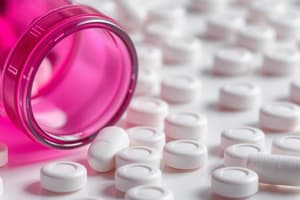Podcast
Questions and Answers
Which of the following drugs is classified as a potassium-sparing diuretic?
Which of the following drugs is classified as a potassium-sparing diuretic?
- Spironolactone (correct)
- Furosemide
- Bumetanide
- Hydrochlorothiazide
What process is primarily increased by diuretic drugs?
What process is primarily increased by diuretic drugs?
- Sodium reabsorption
- Solute secretion
- Urine volume (correct)
- Blood filtration rate
Which term refers to the increased excretion of sodium due to diuretic action?
Which term refers to the increased excretion of sodium due to diuretic action?
- Aquaretic
- Reabsorption
- Filtration
- Natriuresis (correct)
Where in the nephron do thiazide diuretics primarily exert their effect?
Where in the nephron do thiazide diuretics primarily exert their effect?
What is the mechanism of action for loop diuretics such as furosemide?
What is the mechanism of action for loop diuretics such as furosemide?
Which drug is primarily categorized as an osmotic diuretic?
Which drug is primarily categorized as an osmotic diuretic?
Which side effect is commonly associated with potassium-sparing diuretics?
Which side effect is commonly associated with potassium-sparing diuretics?
Which class of diuretics inhibits sodium reabsorption specifically in the proximal convoluted tubule (PCT)?
Which class of diuretics inhibits sodium reabsorption specifically in the proximal convoluted tubule (PCT)?
In which scenario would vasopressin administration likely be beneficial?
In which scenario would vasopressin administration likely be beneficial?
Which of the following drugs is an antagonist at aldosterone receptors?
Which of the following drugs is an antagonist at aldosterone receptors?
What is the mechanism of action for SGLT inhibitors?
What is the mechanism of action for SGLT inhibitors?
What primary effect does vasopressin have when it binds to V2 receptors?
What primary effect does vasopressin have when it binds to V2 receptors?
Which of the following describes a common use for intravenous mannitol?
Which of the following describes a common use for intravenous mannitol?
Which diuretic primarily inhibits sodium and chloride reabsorption in the thick ascending limb (TAL) of the nephron?
Which diuretic primarily inhibits sodium and chloride reabsorption in the thick ascending limb (TAL) of the nephron?
What physiological condition can be treated with Carbonic Anhydrase Inhibitors like acetazolamide?
What physiological condition can be treated with Carbonic Anhydrase Inhibitors like acetazolamide?
Which statement is true about Sodium Glucose Cotransporter 2 (SGLT2) inhibitors?
Which statement is true about Sodium Glucose Cotransporter 2 (SGLT2) inhibitors?
What is a common adverse drug reaction (ADR) associated with Loop Diuretics?
What is a common adverse drug reaction (ADR) associated with Loop Diuretics?
Which of the following is NOT a characteristic of Potassium-Sparing Diuretics?
Which of the following is NOT a characteristic of Potassium-Sparing Diuretics?
Which drug is a Carbonic Anhydrase Inhibitor used for urinary alkalinization and other clinical purposes?
Which drug is a Carbonic Anhydrase Inhibitor used for urinary alkalinization and other clinical purposes?
What could be a serious consequence of using NSAIDs in patients with renal insufficiency?
What could be a serious consequence of using NSAIDs in patients with renal insufficiency?
Which diuretic type often raises plasma uric acid levels due to blocking its secretion?
Which diuretic type often raises plasma uric acid levels due to blocking its secretion?
Which of the following diuretics is most effective at managing acute pulmonary edema?
Which of the following diuretics is most effective at managing acute pulmonary edema?
Which of the following correctly describes the mechanism of action of Nesiritide?
Which of the following correctly describes the mechanism of action of Nesiritide?
Match each word to its definition:
Match each word to its definition:
Match each word to its description:
Match each word to its description:
Match each to its description
Match each to its description
Match each of the following to their actions
Match each of the following to their actions
Match each to its description and location
Match each to its description and location
Match each to its location or corresponding drugs
Match each to its location or corresponding drugs
Match each to its corresponding drugs
Match each to its corresponding drugs
Which of the following is not an ADH antagonist drug?
Which of the following is not an ADH antagonist drug?
Match each renal autacoid to its description
Match each renal autacoid to its description
Which renal autacoid is a peptide that increases GFR and blunts Na+ reabsorption?
Which renal autacoid is a peptide that increases GFR and blunts Na+ reabsorption?
What can cause a rise in adenosine production in the kidneys by decreasing GFR and blood flow?
What can cause a rise in adenosine production in the kidneys by decreasing GFR and blood flow?
What are carbonic anhydrase inhibitors derivatives of?
What are carbonic anhydrase inhibitors derivatives of?
Which of the following drugs is a Carbonic Anhydrase (CA) Inhibitor used for glaucoma?
Which of the following drugs is a Carbonic Anhydrase (CA) Inhibitor used for glaucoma?
Which of the following is not an ADR of Carbonic Anhydrase (CA) Inhibitors?
Which of the following is not an ADR of Carbonic Anhydrase (CA) Inhibitors?
Which group of drugs requires potassium oral supplements with chronic dosing?
Which group of drugs requires potassium oral supplements with chronic dosing?
Which of the following is an adenosine A1 receptor antagonist that acts as a diuretic?
Which of the following is an adenosine A1 receptor antagonist that acts as a diuretic?
What are the most efficacious diuretic agents currently available?
What are the most efficacious diuretic agents currently available?
What do loop diuretics promote the excretion of?
What do loop diuretics promote the excretion of?
Match each drug group to its clinical uses
Match each drug group to its clinical uses
Which of the following are antagonistic drugs to vasopressin? (Select all that apply)
Which of the following are antagonistic drugs to vasopressin? (Select all that apply)
Where is vasopressin (ADH) released from?
Where is vasopressin (ADH) released from?
How is mannitol administered?
How is mannitol administered?
Match each potassium-sparing diuretic to its mechanism of action (MOA):
Match each potassium-sparing diuretic to its mechanism of action (MOA):
Which loop diuretic cannot cause a sulfa allergic reaction?
Which loop diuretic cannot cause a sulfa allergic reaction?
Which drugs have the following ADRs:
- may block uric acid secretion and raise plasma uric acid levels
- may elevate blood glucose levels
- hyponatremia
- sulfa allergic reactions possible?
Which drugs have the following ADRs:
- may block uric acid secretion and raise plasma uric acid levels
- may elevate blood glucose levels
- hyponatremia
- sulfa allergic reactions possible?
What is the mechanism of action (MOA) of furosemide?
What is the mechanism of action (MOA) of furosemide?
What electrolyte abnormalities can be caused by furosemide? (Select all that apply)
What electrolyte abnormalities can be caused by furosemide? (Select all that apply)
Which class of diuretics might be used IV to treat a severe case of hypercalcemia?
Which class of diuretics might be used IV to treat a severe case of hypercalcemia?
Which one of the following pairs is NOT correct?
Which one of the following pairs is NOT correct?
Which of the following drugs are used to treat diabetes mellitus?
Which of the following drugs are used to treat diabetes mellitus?
Which of the following classes of drugs can increase uric acid levels, leading to gout?
Which of the following classes of drugs can increase uric acid levels, leading to gout?
Which of the following is a rare and reversible adverse drug reaction (ADR) of loop diuretics?
Which of the following is a rare and reversible adverse drug reaction (ADR) of loop diuretics?
What is GFR most often measured by?
What is GFR most often measured by?
Which of the following is an ADR of osmotic diuretics?
Which of the following is an ADR of osmotic diuretics?
Flashcards
Diuresis
Diuresis
An increase in the volume of urine produced by the kidneys.
Diuretic
Diuretic
A drug that increases urine output by promoting fluid excretion from the body.
Natriuretic
Natriuretic
A drug that increases the excretion of sodium (Na+) ions in urine, thereby promoting water excretion.
Aquaretic
Aquaretic
Signup and view all the flashcards
Filtration
Filtration
Signup and view all the flashcards
Carbonic Anhydrase Inhibitors
Carbonic Anhydrase Inhibitors
Signup and view all the flashcards
Carbonic anhydrase
Carbonic anhydrase
Signup and view all the flashcards
SGLT2 Inhibitor
SGLT2 Inhibitor
Signup and view all the flashcards
Loop Diuretics
Loop Diuretics
Signup and view all the flashcards
Hydrochlorothiazide
Hydrochlorothiazide
Signup and view all the flashcards
Potassium-Sparing Diuretics
Potassium-Sparing Diuretics
Signup and view all the flashcards
Aldosterone
Aldosterone
Signup and view all the flashcards
Adenosine
Adenosine
Signup and view all the flashcards
Prostaglandins
Prostaglandins
Signup and view all the flashcards
Nesiritide
Nesiritide
Signup and view all the flashcards
What do Spironolactone and eplerenone do in the kidneys?
What do Spironolactone and eplerenone do in the kidneys?
Signup and view all the flashcards
How do Amiloride and triamterene work?
How do Amiloride and triamterene work?
Signup and view all the flashcards
What does Mannitol do in the kidneys?
What does Mannitol do in the kidneys?
Signup and view all the flashcards
What is the function of Vasopressin (ADH)?
What is the function of Vasopressin (ADH)?
Signup and view all the flashcards
How do Conivaptan and Tolvaptan work?
How do Conivaptan and Tolvaptan work?
Signup and view all the flashcards
What do Carbonic Anhydrase Inhibitors do?
What do Carbonic Anhydrase Inhibitors do?
Signup and view all the flashcards
What do Loop Diuretics do?
What do Loop Diuretics do?
Signup and view all the flashcards
What do Thiazide diuretics do?
What do Thiazide diuretics do?
Signup and view all the flashcards
Study Notes
Diuretic Drugs
- Diuretics increase urine volume
- Diuretic drugs increase urine volume
- Natriuretic increases sodium excretion
- Aquaretic increases excretion of solute-free water
- Solute is any dissolved ions, molecules, etc.
- PCT is proximal convoluted tubule
- TAL is thick ascending limb
- DCT is distal convoluted tubule
- SGLT is sodium-glucose co-transporter
- NaHCO₃ is sodium bicarbonate
- GFR is glomerular filtration rate
Drug Classes and Actions
- Carbonic Anhydrase (CA) Inhibitors: Block reabsorption of NaHCO₃ in the PCT
- SGLT Inhibitors: Inhibit sodium/glucose transporter in the PCT
- Loop Diuretics: Inhibit NaCl reabsorption in the TAL
- Examples include: furosemide, bumetanide, torsemide, ethacrynic acid
- Thiazide Diuretics: Inhibit NaCl reabsorption in the DCT
- Examples include: hydrochlorothiazide, bendroflumethiazide, metolazone, chlorthalidone, trichlormethiazide
- Potassium-Sparing Diuretics: Prevent potassium secretion by blocking aldosterone
- Examples include: spironolactone, eplerenone, amiloride, triamterene
Other Terms
- Diuresis: Increase in urine volume
- Reabsorption: Removal of solutes and water from the tubules back into the blood
- Secretion: Removal of solutes from the blood into the tubules
Clinical Uses
- Diuretics are used to treat hypertension, heart failure, kidney calcium stone formation, and nephrogenic diabetes insipidus.
- Some diuretics can be used to treat hypercalcemia and acute pulmonary edema, although it varies with specific diuretic drug.
Additional Information
- Some diuretics are derived from sulfonamides (e.g., hydrochlorothiazide).
- Certain diuretics have a sulfa group possibly causing allergic reactions in patients that are sensitive to sulfa drugs.
- Caffein is an adenosine antagonist and can act as diuretic.
- Some of the diuretic drugs are not derived from the sulfa group.
- Ethacrynic acid is generally not associated with sulfa allergy.
- Some diuretics cause significant potassium loss (e.g., loop and thiazide diuretics); potassium supplements may be necessary in such cases. hyperchloremic metabolic acidosis is a potential side effect.
- Some diuretics can cause hyperkalemia and gynecomastia.
- Osmotic diuretics (mannitol) are primarily used for increasing glomerular filtration rate and for reducing intracranial and intraocular pressure.
Studying That Suits You
Use AI to generate personalized quizzes and flashcards to suit your learning preferences.




